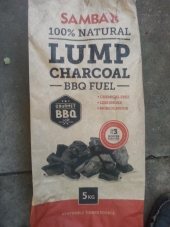



Craig Overend wrote:The product sheet says: "
SAMBA® Lump Charcoal 5kg is made
from renewable timber. Logs are lit
and wood smolders for a few days -
what is left is almost pure carbon also
known as ‘lump charcoal’. This allows
SAMBA® Lump Charcoal 5kg to
light easy and heat hotter than other
BBQ fuels with less smoke and it is
chemical free. The rich wood aroma
complements the natural flavours of
your choice of meat. "
It should be fine if you've soaked it. Just make sure you add it to soil and not to any leaf matter you might eat as cow manure can harbour human pathogens but the ones I know about tend not to persist in the soil.
The only part I'd question is if it's made in Victoria and trucked to WA then it's not very local. You can email them at sales@denbies.com.au to ask if you're concerned.

Marco Banks wrote:Drive over the bag a few times with your car or truck to crumble it. Huge chunks of bio-char are not as good as smaller pieces bio-char, as what you are looking for is surface area for microbes to attach themselves to. The metaphor you always hear with biochar is that it creates a reef for microbes to colonize. So a 2 inch chunk or charcoal has a lot of surface area, but take that same chunk and break it down to pea-sized pieces, and you'll have exponentially (hundreds of times) more surface area.
I've use a heavy steel tamper that is used for packing down soil or sand when you are trying to get the air out (for example, before you lay pavers in sand). http://www.bettymills.com/tampers-jackson-professional-tools-027-1133400?utm_source=cpc-strat&utm_medium=cpc&utm_campaign=parts&utm_keyword=JCP027-1133400&utm_content=Facility&gclid=CLLAn7DOj88CFcZffgod7R8CZg
I thrown down a scrap piece of plywood and use that tamper to pulverize the charcoal. It works great for this purpose. I've seen people use the top of a sledge hammer (held upside down by the handle) and a five gallon pail. (Its easy to crack the bottom of the bucket this way if you're not careful). Any kind of heavy hand tool and a hard flat anvil-like surface (a piece of plywood, a sidewalk . . .) will work.
Once you've got your bag smashed down into crumbled biochar, dump it into a 5 gallon pail with a mix of healthy garden soil, well-seasoned compost, fresh compost, a bit of manure, and lots of rain water. That mix will contain a wide variety of microbes. Mix it all together in a slurry and leave it for at least a couple of hours before you begin to put in around the root zone of your plants and trees. Tap water will contain chlorine -- a killer of all those lovely microbes you are trying to get to glom onto your biochar. If you only have tap water, let it sit in a bucket for 2 days till the chlorine gasses off.
You won't want to leave your biochar slurry in the bucket for too long, as all the oxygen will be used up quickly and it'll start to kill your microbial herd. If you mix it up and want to save it, dig a pocket into the top of your compost pile and dump your biochar slurry there. The water will drain off, but the microbes that have colonized your biochar will still be attached. Put a couple of inches of compost or fresh biomass on top of it, as the sun will irradiate the inoculated bio-char and kill your microbes. UV rays are microbe killers. When you are ready to use your biochar, it'll be even more healthy if it's sat there for some time in a healthy compost pile. Of course, if you turn your pile, you'll just be integrating all that biochar throughout. That's not a bad thing -- it'll all eventually make its way into your soil profile.

Sarah Merlin wrote:Hello, first post

I am trying to use biochar to improve some very sandy soil in Perth, Western Australia. I am very new to all of this, and was hoping to use store bought lump charcoal rather than making my own. I am living on a small suburban rented lot, and burning my own material for it isn't really an option at the moment. From what I have read there seems to be some disagreement about whether this is a good idea due to nasty stuff that could be in the lump charcoal. However this type I bought appears to be rather clean? I have attached photos of the bag.
Would love some opinions on whether this is a good idea or a bad idea. I hope it is because I have already mixed it in a 1 to 3 ratio with cow manure to soak/innoculate. Just don't want it to kill my whole garden or something. :p

